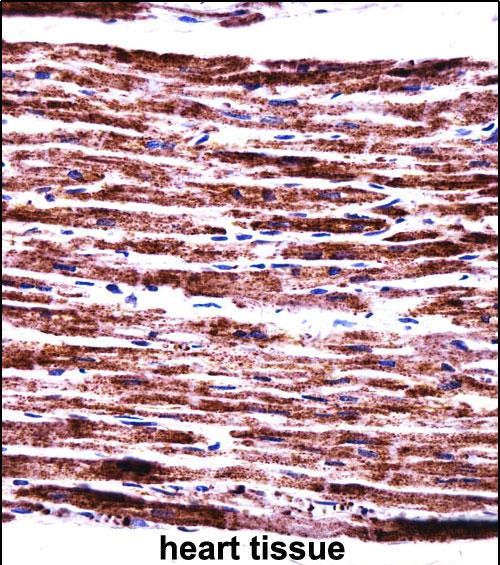PERP Antibody (C-term)
Affinity Purified Rabbit Polyclonal Antibody (Pab)
- 产品详情
- 实验流程
- 背景知识
Application
| WB, IHC-P, E |
|---|---|
| Primary Accession | Q96FX8 |
| Other Accession | NP_071404.2 |
| Reactivity | Human |
| Host | Rabbit |
| Clonality | Polyclonal |
| Isotype | Rabbit IgG |
| Calculated MW | 21386 Da |
| Antigen Region | 162-191 aa |
| Gene ID | 64065 |
|---|---|
| Other Names | p53 apoptosis effector related to PMP-22, Keratinocyte-associated protein 1, KCP-1, P53-induced protein PIGPC1, Transmembrane protein THW, PERP, KCP1, KRTCAP1, PIGPC1, THW |
| Target/Specificity | This PERP antibody is generated from rabbits immunized with a KLH conjugated synthetic peptide between 162-191 amino acids from the C-terminal region of human PERP. |
| Dilution | WB~~1:1000 IHC-P~~1:100~500 E~~Use at an assay dependent concentration. |
| Format | Purified polyclonal antibody supplied in PBS with 0.09% (W/V) sodium azide. This antibody is purified through a protein A column, followed by peptide affinity purification. |
| Storage | Maintain refrigerated at 2-8°C for up to 2 weeks. For long term storage store at -20°C in small aliquots to prevent freeze-thaw cycles. |
| Precautions | PERP Antibody (C-term) is for research use only and not for use in diagnostic or therapeutic procedures. |
| Name | PERP (HGNC:17637) |
|---|---|
| Function | Component of intercellular desmosome junctions (By similarity). Plays a role in stratified epithelial integrity and cell- cell adhesion by promoting desmosome assembly (By similarity). Thereby plays a role in barrier function of the skin against infection (By similarity). Plays a role in mammary epithelial tissue homeostasis and remodeling during and after pregnancy, potentially via its involvement in desmosome cell-cell junctions (By similarity). Required for tooth enamel development via facilitating desmosome-mediated ameloblast adhesion to the stratum intermedium during the transitional stage of amelogenesis (By similarity). May also play a role in downstream transcriptional regulation of other genes involved in amelogenesis such as AMBN, ENAM, MMP20 and KLK4 (By similarity). Plays a role as an effector in the TP53-dependent apoptotic pathway (By similarity). Positively regulates apoptosis in T-helper 17 (Th17) cell populations via caspase-dependent signaling (By similarity). Promotes neutrophil transepithelial migration in response to chemoattractants such as hepoxilin A3 (HXA3), N-Formylmethionyl-leucyl-phenylalanine (fMLP) and CXCL8/IL-8 (PubMed:25486861). Required for neutrophil transepithelial migration in response to S.typhimurium infection (PubMed:25486861). May act as a positive regulator of endothelial cell apoptosis in response to blood flow-derived shear stress (By similarity). |
| Cellular Location | Cell junction, desmosome {ECO:0000250|UniProtKB:Q9JK95}. Cell membrane; Multi-pass membrane protein. Cytoplasm. Note=Associated with desmosomes (By similarity). Colocalizes with KRT14 in the cell membrane (PubMed:31898316). Clusters in a punctate pattern throughout the epithelial cytoplasm, in response to S.typhimurium infection (PubMed:25486861). {ECO:0000250|UniProtKB:Q9JK95, ECO:0000269|PubMed:25486861, ECO:0000269|PubMed:31898316} |
| Tissue Location | Expressed in skin, heart, placental, liver, pancreas, keratinocytes and dermal fibroblasts. May translocate to the intestinal apical epithelial cell surface via sipA and sctB1/sipC- promoted exocytic translocation following infection by S. Typhimurium (PubMed:25486861, PubMed:27078059). |
For Research Use Only. Not For Use In Diagnostic Procedures.
Provided below are standard protocols that you may find useful for product applications.
BACKGROUND
Component of intercellular desmosome junctions. Plays a role in stratified epithelial integrity and cell-cell adhesion by promoting desmosome assembly. Plays a role as an effector in the TP53-dependent apoptotic pathway (By similarity).
REFERENCES
Bailey, S.D., et al. Diabetes Care 33(10):2250-2253(2010)
Liu, C.Y., et al. Carcinogenesis 31(7):1259-1263(2010)
Yarden, R.I., et al. Mol. Carcinog. 49(6):545-555(2010)
Talmud, P.J., et al. Am. J. Hum. Genet. 85(5):628-642(2009)
Beaudry, V.G., et al. Am. J. Med. Genet. A 149A (9), 1952-1957 (2009) :
终于等到您。ABCEPTA(百远生物)抗体产品。
点击下方“我要评价 ”按钮提交您的反馈信息,您的反馈和评价是我们最宝贵的财富之一,
我们将在1-3个工作日内处理您的反馈信息。
如有疑问,联系:0512-88856768 tech-china@abcepta.com.























 癌症的基本特征包括细胞增殖、血管生成、迁移、凋亡逃避机制和细胞永生等。找到癌症发生过程中这些通路的关键标记物和对应的抗体用于检测至关重要。
癌症的基本特征包括细胞增殖、血管生成、迁移、凋亡逃避机制和细胞永生等。找到癌症发生过程中这些通路的关键标记物和对应的抗体用于检测至关重要。 为您推荐一个泛素化位点预测神器——泛素化分析工具,可以为您的蛋白的泛素化位点作出预测和评分。
为您推荐一个泛素化位点预测神器——泛素化分析工具,可以为您的蛋白的泛素化位点作出预测和评分。 细胞自噬受体图形绘图工具为你的蛋白的细胞受体结合位点作出预测和评分,识别结合到自噬通路中的蛋白是非常重要的,便于让我们理解自噬在正常生理、病理过程中的作用,如发育、细胞分化、神经退化性疾病、压力条件下、感染和癌症。
细胞自噬受体图形绘图工具为你的蛋白的细胞受体结合位点作出预测和评分,识别结合到自噬通路中的蛋白是非常重要的,便于让我们理解自噬在正常生理、病理过程中的作用,如发育、细胞分化、神经退化性疾病、压力条件下、感染和癌症。







